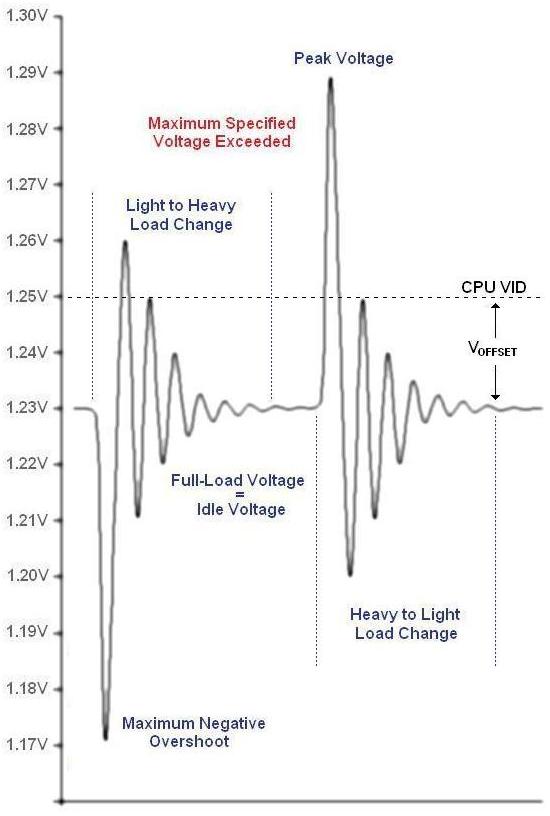Overclocking Intel's New 45nm QX9650: The Rules Have Changed
by Kris Boughton on December 19, 2007 2:00 AM EST- Posted in
- CPUs
Intel Processor Power Delivery Guidelines (Cont'd)
In this next case we eliminate Vdroop altogether and examine the chaos that ensues. As illustrated by our model, removing Vdroop does nothing to reduce the magnitude of the idle to full-load transient but does increase the settling time as the VRM must recover to a higher final regulation voltage. As in the case of no Voffset, it is possible to exceed the maximum allowable CPU voltage (VID). Clearly, removing Vdroop gains us nothing and only serves to create problems that are more serious.

No Vdroop means the VRM circuit must work harder at maintaining a constant voltage
So what happens when we remove both Voffset and Vdroop? The answer is simple - bad things. Although the difference between the maximum positive and negative peak overshoot are the same, severe violations to the CPU VID limit occur. If you're asking yourself what's the problem with this, consider the case of a CPU VID of 1.60000V - because the user feels this is the absolute maximum CPU voltage that they will allow. Just how high do you think CPU voltage will go after leaving a heavy load condition? We can't be sure without knowing more of the details, but we can certainly conclude that it will be well in excess of 1.6V. If you've ever run a benchmark only to have your system crash right as it finishes then you have experienced the consequences of this poor setup.

The user gives up all control over the CPU supply voltage with no Voffset or Vdroop
Finally, let's take one last real-world look at the consequences of removing Vdroop. ASUS' implementation of this feature, labeled as Load Line Calibration and included with their latest line of motherboards, is particularly worthy of our attention for a number of reasons. The first is that setting lower voltages with this option enabled actually results in a condition in which the CPU voltage under load is higher than the idle voltage. Imagine our confusion as we desperately struggle to understand why our system is Prime95 stable for days yet continues to crash under absolutely no load. What's more, in spite of the absence of droop and for reasons unknown, enabling this feature artificially raises our CPU's minimum stable core voltage at 4.0GHz from 1.28V to about 1.33V. As a result, our system uses more power under load than is otherwise necessary. Our efforts to reduce our processor's supply voltage backfired - instead of lowering the system's total power consumption we managed to affect a 20W increase.

Suffice it to say, we found it better to leave Load Line Calibration disabled
With Load Line Calibration disabled in BIOS, setting a CPU Voltage VID of 1.38750 resulted in a no-load voltage of about 1.34V and a full-load value of 1.28V. Enabling this feature and lowering the VID to 1.35000V produced a constant CPU supply voltage, regardless of load (or so it seemed), of 1.33V. Setting a lower VID resulted in a blue screen during Windows boot. Idle voltage was relatively unchanged at about 1.33-1.34V but the full-load voltage required increased by 50mV with no benefit. As you might guess, we recommend you leave this option disabled.
Hopefully we've shown you enough to understand exactly why Voffset and Vdroop are important. Please give second thought to your actions if you're in the habit of defeating these essential system safeguards.










56 Comments
View All Comments
Aivas47a - Wednesday, December 19, 2007 - link
Great article. You guys have really been distinguishing yourselves with in-depth work on overclocking the last few months: exploring obscure bios settings, tinkering with "extreme" cooling -- keep it up!My experience with a qx9650 so far is very similar to yours: easy scaling to 4 ghz, difficult scaling after that with 4.2 ghz being the practical max for regular operation (folding, etc.).
One issue I will be interested to see you address in the future is fsb overclocking on yorkfield. So far I am seeing yorkfield top out at lower fsb (450-460) than was possible for kentsfield on a comparable P35 or X38 platform. That is not so significant for the unlocked Extreme Edition chips, but could make it difficult to achieve the magic 4 ghz with the q9550 and especially the q9450.
Aivas47a - Wednesday, December 19, 2007 - link
Great article. You guys have really been distinguishing yourselves with in-depth work on overclocking the last few months: exploring obscure bios settings, tinkering with "extreme" cooling -- keep it up!My experience with a qx9650 so far is very similar to yours: easy scaling to 4 ghz, difficult scaling after that with 4.2 ghz being the practical max for regular operation (folding, etc.).
One issue I will be interested to see you address in the future is fsb overclocking on yorkfield. So far I am seeing yorkfield top out at lower fsb (450-460) than was possible for kentsfield on a comparable P35 or X38 platform. That is not so significant for the unlocked Extreme Edition chips, but could make it difficult to achieve the magic 4 ghz with the q9550 and especially the q9450.
Doormat - Wednesday, December 19, 2007 - link
Though its somewhat disappointing on the rumors that Intel has postponed the launch of their QuadCore desktop chips from January to March.Sunrise089 - Wednesday, December 19, 2007 - link
I agree with everyone else - really top notch stuff here.1 glaring typo though, from the first page: "Moving to a smaller node process technology allows for the potential of one or two things to happen. " - the "or" should be an "of"
ChronoReverse - Wednesday, December 19, 2007 - link
It seems that ATI cards have less of a drop going from XP to Vista (down to zero and even negative sometimes). It might be instructive to use that for the charts that compare Vista to XP for 3D (e.g., the 3Dmark06 benchmark).melgross - Wednesday, December 19, 2007 - link
Capacitors have their capacitance turned into reactance at higher frequencies. Anything that qualifies, in a circuit, as a capacitor, such as two wires riding in parallel, will have, to a greater or lesser extent, the same problem in the design.Reactance rolls off high frequencies. More power is required to offset that.
This is the same problem whether dealing with low frequencies in an audio circuit (where it may be less of a problem), or a high performing computer. It's almost impossible to eliminate all stray capacitance from a circuit, and more circuitry becomes capacitive at higher frequencies. This will only increase as a problem as we get to smaller processes, such as 32nm.
andyleung - Wednesday, December 19, 2007 - link
I am very interested in the performance of these new CPUs. They are Quad-Core and they are good enough to perform some heavy duty business tasks. Wondering how they work with JEE performance.BLHealthy4life - Wednesday, December 19, 2007 - link
This article is a perfect example of what makes Anandtech so great. Anandtech has the most brilliant and most technically savvy guys on the internet.Very rarely will you fine any other website review pieces of hardware with such intricate detail for hardware specs and the technology behind it.
Great work guys!
BL
kkak52 - Wednesday, December 19, 2007 - link
really an informative article.... good work!Bozo Galora - Wednesday, December 19, 2007 - link
A 10+ article, especially the vdroop section.Its nice to see something on AT like the old days thats cuts through the BS and actually gives real usable info.
Quite a tour de force.
Nice work.